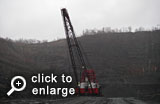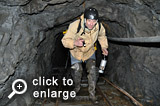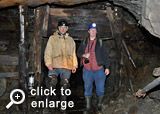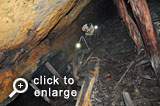June 2nd, 2011
Coal is a four-letter word. These days, it's hard to even mention its name without bringing divergent points of view to a boil. The first recorded anti-coal legislation dates back to 1306 when British Paliament, disgusted by the coal-fired soot and smog filling London's streets, outlawed its use. Seven hundred years later, its carbon-and-sulphur laced emissions and environmentally disasterous mining techniques still put it at the top of every environmentalist's shit list. On the other hand, it powered the industrial revolution, continues to be a cheap and available form of power, and it's abundance in North America actually spared countless acres of forest from the furnaces of industrial America. The irony is that it is a form of solar power: Photosynthesized solar energy stored as carbon by plants millions of years ago.



 1:
1: Vintage poster, advertisement
2: Anthracite miners, 1950s
3: Anthracite coal
4: A modern "mine". Undergound mines have largely been replaced by strip mining operations.
The central Appalacian mountains in Northeastern Pennsylvania have a history inextricably linked to coal. Coal mining in Northeastern Pennsylvania predates the American Revolution, and this particular area holds the vast majority of the world's known supply of Anthracite coal.
There are lots of varieties of coal. There is Anthracite, Bituminous, Lignite, Blind coal, Kilkenny coal, and Crow coal just to name a few. But Anthracite is the hardest, purest, cleanest and longest burning coal. It is the highest grade of coal, and the most expensive. Because of it's superior quality it was the preferred fuel for America's home heating and industrial needs during much of the 19th and 20th Centuries.
But Anthracite coal as an industry has been in decline for decades. America's switch to oil and gas for home and industrial use has shrunk the Anthracite market. Although 60% of America's energy is still supplied by coal-fired power plants, the energy companies prefer less costly coal over Anthracite. It is the combination of reduced demand and newer mining techniques (that employ far fewer miners) that has reduced Anthracite's economic presence in Northeastern Pennsylvania.
Gone are the days when thousands of headlamped men labored underground. Today, a handful of heavy equipment operators can exceed the daily output of hundreds of underground miners in just a few hours without ever going underground. The old miner culture - the people, places, stories, struggles, jobs - are fading fast in Northeastern PA. I wanted to capture something.
Anthracite Coal Country is no small subject to tackle so I did it in my usual way. Rather than take on its history in a documentary with interviews and narration, I decided to find the remaining structures themselves and let them do the talking. When I make these films my goal is not necessarily to educate. My only hope is that my work may ignite a viewer's curiosity, and that might lead them to their own journey of discovery.


 Top:
Top: Me exploring an underground coal mine
Middle: Me (left) with mine explorer Jim
Bottom: Me setting up a shot.
If my subject was to be coal, then surface-level structures alone would not suffice. Coal's Kingdom is largely an underground world and a film like mine would have been incomplete without exploring the mines themselves. But as difficult as it was finding the remaining surface-level structures, it proved many magnitudes more difficult finding the underground ones. And for good reason: exploring underground mines is stupid. Besides the obvious risks of bad falls and things collapsing, coal mines are notorious for oxygen-quality issues. Over the years, many curious coal mine explorers (and coal miners) have suffocated to death. Coal emits carbon dioxide. Add that to the other existing underground gasses and oxygen may be in short supply. Active coal mines would be ventilated with large surface-level fan houses, but in abandoned mines the gasses just sit and accumulate. Mining companies and the Federal Government have been working for decades to find and seal open mine portals. To make a long story short, finding and exploring an abandoned coal mine required me to do my homework - and get some gear.
After much preparation I mounted my first trip, alone, to an abandoned mine (I asked some friends if they wanted to join me but got no takers). After some bushwhacking I found myself standing before the portal. My only problem was that it had been recently sealed. A new, heavy-duty bat gate had been installed effectively shutting me out. Back to the drawing board. By the time I had my first success it only proved that I lacked adequate light to properly illuminate the inside of a coal mine. I upgraded my gear and joined forces with an intrepid mine explorer named Jim. Jim has a passion for off-roading in abandoned strip mines - while listening to Wagner operas. I was very glad for his company, and together we explored two incredible coal mines.
Coal's Kingdom is just my attempt to understand, connect to, and to some extent document King Coal's lost world: from down in the mines to up in the breaker, into the coal camps where yesterday's miners lived. In Northeastern Pennsylvania, Coal's Kingdom is fading fast. But if you know where to look you can transport yourself back to the time when Coal was King.